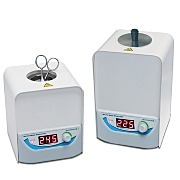Sterilization is a process designed to destroy and remove all forms of life present in a certain region. It’s accomplished by use of physical or chemical means. Autoclaves, for example, steam sterilize by high pressure and heat (250°F/121°C at the low end).
Another sterilization-by-heating technique uses infrared to kill microorganisms in a few seconds using temperatures up to 1500°F/815°C. On the chemical front, hydrogen peroxide can break down cellular tissue.

Bactizapper™ Infrared sterilizer from Benchmark Scientific
Sterilization can also be used to eliminate quasi-living biological agents, such as viruses and prions, which many scientists are not convinced是“alive.” Failure to remove viruses and prions from instruments and surfaces can present serious ramifications for patient and personnel safety, so it’s important to select the most-appropriate sterilization technique.
Sterilization versus Disinfection
Sterilization is distinguished from disinfection in that it kills, deactivates or eliminates全部forms of life or biological agents. Disinfection refers specifically to the removal of有害生物剂。实际上,在医院等关键卫生情况下可能需要灭菌,而消毒是您在厨房或浴室中使用的过程。
Forms of Physical Sterilization

基准科学的Bioclave™高压釜
许多技术可用于对表面进行消毒。首先,热量和压力可以从仪器和设备中去除不稳定的物质。生物化合物,例如某些蛋白质和病毒,在灭菌过程中提出挑战。例如,已证明王室可以通过热量和压力以及许多化学物质和酶来抵抗变性。建议对这些化合物的共价修饰进行去除。
接下来,电离辐射(例如X射线)也是一种有效的灭菌剂,可从分子释放电子。由于许多可传播药物需要DNA和RNA进行繁殖,因此切断核酸骨架可能是减少其传播的有用手段。尽管该技术已被证明对安全消毒有效,但必须密切注意随后去除这些化合物,因为细菌和真菌孢子抵抗大多数辐照技术。
Another technique uses Ultra-Violet C (UVC) lamps. UVC rays generated by the sun are filtered out by the earth’s atmosphere; microorganisms have no natural resistance to the damage they cause. When UVC lamps (280 – 100 nm) are used for sterilization, they damage cells and disrupt DNA sequencing. It is safe for personnel as long as they avoid exposure to the lamp; perform timed cycles in sealed areas (during off-hour shifts, for example).

光谱,详细介绍了超紫色范围。
为了有效,灯必须与物体具有直接的视线。其他考虑因素包括曝光时间和灯强度;远离灯的物体可能无法正确消毒。注意:随着时间的流逝,UVC射线会损坏一些塑料材料。

Torch™ portable room UV disinfection tower by ClorDiSys radiates 360 degrees.
Lastly, chemical filtration of compounds is useful for disinfecting media used in life science research. This disinfection technique typically relies on the exclusion of biological materials based on particle size. While this is an adequate procedure for reducing contaminants, it must be used in conjunction with other sterilizing techniques to ensure that the contaminants are not reintroduced during a downstream process.
普通化学灭菌器
氧化乙烷(ETO)通常用于对大于140°F/60°C和/或辐射的温度敏感的物体进行消毒。其中包括塑料组件或耗材,光学和电子设备。高温可以轻松损坏塑料和光学元件,并使该设备不适合其原始应用。因此,ETO通常用于对耐用的医疗设备和预包装的一次性导管和内窥镜进行消毒。该化学物质对DNA具有破坏性作用,使微生物无法繁殖。虽然这种灭菌程序会产生良好的结果,但必须注意,ETO是已知的致癌物,如果不仔细监测,对人员会带来严重的风险。
Hydrogen Peroxide Vapor (HPV) is another chemical that’s effective in removing biological agents from the surfaces of furniture, equipment and other difficult-to-sterilize surfaces. The ability of the vapor to permeate the desired area can effectively be used to sterilize pass-through chambers and devices used in hospital and manufacturing settings. Personnel need to be careful of over-exposure, as it can have damaging effects. While UVC irradiation can also be employed for these purposes, HVP isn’t limited by direct visual contact.
Final Thoughts
While many of these individual methods are capable of effectively sterilizing surfaces, they are commonly used in combination to develop a robust sterilization protocol. While sterilization itself does not require downstream validation for use in a manufacturing setting, it is highly recommended that these processes are closely monitored and quantified wherever possible to ensure safe, reliable results that increases both patient and personnel safety.
阅读有关高压灭菌,紫外线和红外线的更多信息2018beplay available from Laboratory-Equipment.com.
Photo byotisarchives3
Try before you buy!
DEMO MODELS AVAILABLE
Contact us for Demos, Samples, Brochures and more.
EMAILMon - Fri, 5:30am - 5:30pm PST


















